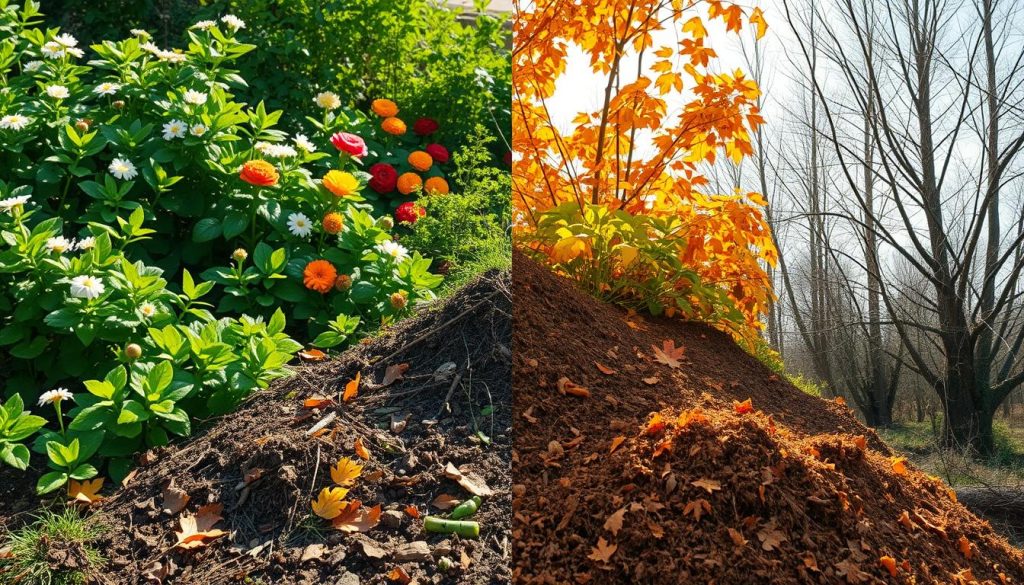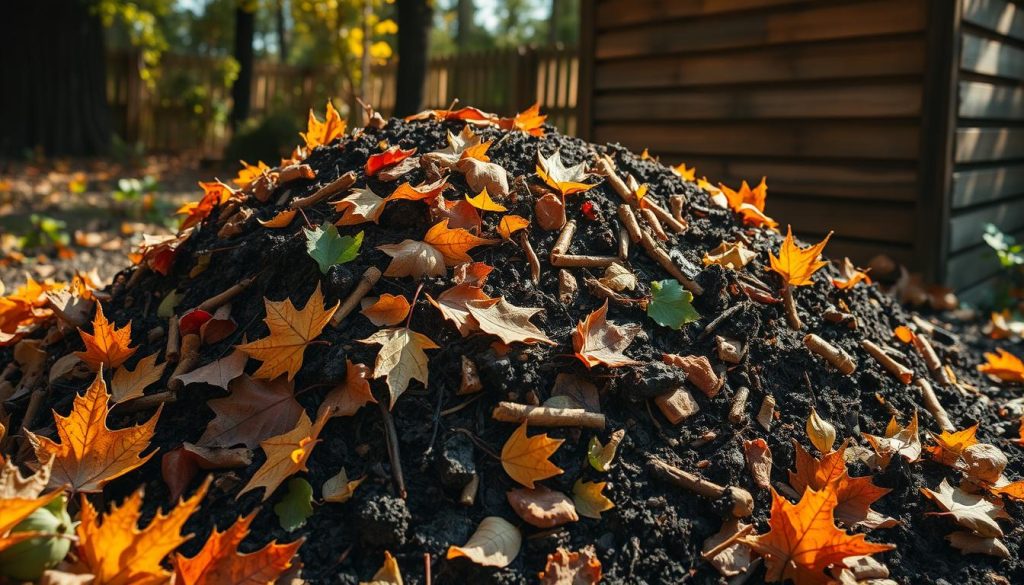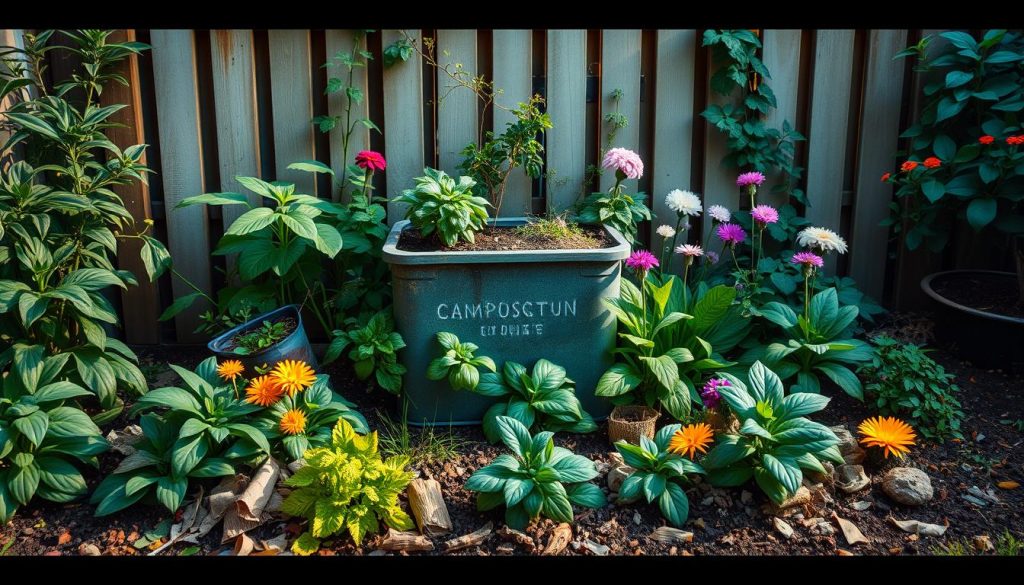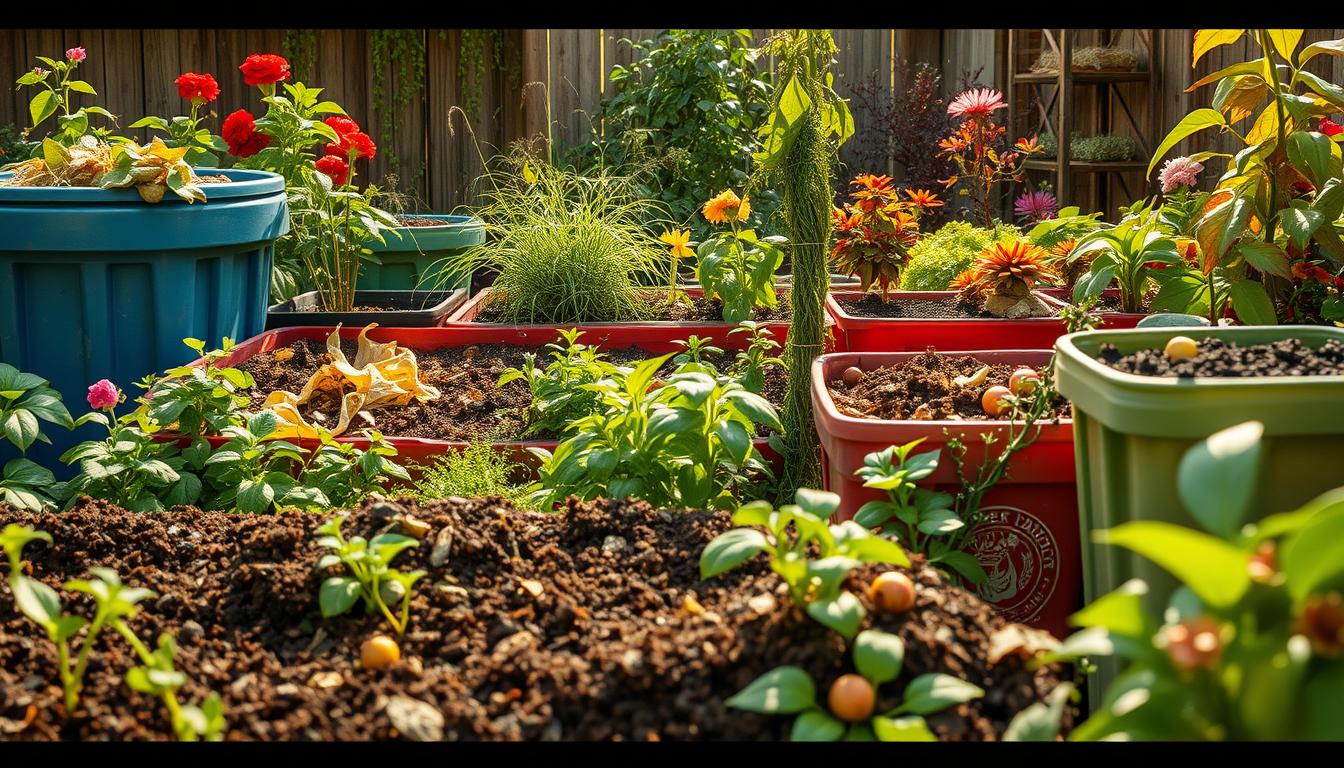As a gardener, I’ve found that the best composting practices are key. They help keep your garden healthy and full of life. My seasonal composting tips will show you how to make soil that’s full of nutrients for your plants. I’ll also share tips on managing organic waste to get you started.
In this article, I want to share my knowledge with you. I’ll teach you how to make your garden lush using seasonal composting tips. By following these methods, you’ll manage your organic waste well. Your garden will soon become the talk of the town.
Understanding the Basics of Composting
As a gardener, I’ve found composting key to a lush garden. It’s about breaking down organic stuff into a soil full of nutrients. This method is great for the planet and my garden.
First, you need to know what can go into compost. Food scraps, leaves, and grass clippings are good. They make a soil that helps plants grow well. Composting cuts down on synthetic fertilizers and boosts soil health.
- Balance green and brown materials to create a healthy compost pile
- Maintain adequate moisture and aeration to support decomposition
- Avoid adding meat, dairy, and oils to the compost pile, as they can attract pests and create unpleasant odors
By following these tips, I keep my compost pile healthy. This helps my garden and the environment.
Spring Composting Techniques
Spring brings new life, and it’s the perfect time to start composting. Composting in different seasons needs a special approach. A good composting guide helps you through it. This season, aim to make a compost pile that helps your spring plants grow.
To start, prepare your compost bin for spring. Mix “green” materials like fresh grass clippings and kitchen scraps with “brown” materials like dried leaves and shredded newspaper. A good pile has more brown materials to avoid overheating.
Preparing My Compost Bin for the Season
Before adding new stuff, clean and aerate your compost bin. This stops anaerobic microorganisms and bad smells.
Adding Fresh Green Material
Fresh green materials add nitrogen and start the composting. My favorites include:
- Fresh grass clippings
- Kitchen scraps, like fruit and vegetable peels
- Manure from herbivores, like rabbits or horses
Balancing Nitrogen and Carbon
When adding green materials, balance them with brown ones. This balance is key for a healthy compost pile. With these tips and a good guide, you’ll have compost that makes your garden thrive.

Summer Composting Strategies
As summer comes, my compost pile needs extra care. High temperatures and moisture can attract pests and cause odors. I’ve found ways to keep my compost pile balanced and healthy.
Managing organic waste is key in summer composting. I mix “green” materials like food scraps and grass clippings with “brown” materials like dried leaves. This mix helps prevent pests and odors.
Keeping My Compost Mixture Aerated
To keep my compost aerated, I turn the pile often. This introduces oxygen and speeds up decomposition. I also add straw or shredded newspaper to absorb moisture and improve airflow.
Managing Heat and Moisture Levels
It’s important to manage heat and moisture in summer. I regularly check the pile’s temperature and moisture. If it’s too hot, I add brown materials. If it’s too dry, I add green materials.
How to Handle Pests in the Compost
Pests can still be a problem, even with good care. I use natural methods like diatomaceous earth or water to control them. I also bury food scraps deep in the pile to avoid attracting pests.
By using these strategies, I keep my compost pile healthy. It supports my sustainable gardening and effective waste management.
Fall Composting Essentials
As the seasons change, we need to adjust our composting. Fall is key for composting, preparing our pile for winter. By following tips and maintaining our pile, we make nutrient-rich compost for winter.
We start by collecting leaves and debris. Rake leaves into a pile and add them to our bin. It’s crucial to balance the carbon-to-nitrogen ratio. We mix “green” materials like food scraps with “brown” materials like leaves.
Preparing for Winter Composting
As it gets colder, we must prepare our compost for winter. Add insulation like straw or newspaper to the top. Keep the pile moist but not soggy to help microorganisms grow.

The Benefits of Chestnut Shells
Chestnut shells are great for our compost pile. They add carbon and balance pH levels. Add them in the fall with other materials for a diverse compost.
By following these tips, we create a healthy compost pile. Focus on maintenance and balance to get the best compost. This supports plant growth all year.
Winter Composting Tips
Many think composting stops when it gets cold. But, with the right methods, your compost can thrive in winter. I’ve seen big improvements in my garden by using eco-friendly composting.
Keeping your compost bin active in cold weather can be tough. But, there are ways to keep it going. Here are some tips to help you:
- Keep your compost bin in a sheltered location to protect it from harsh winds and freezing temperatures.
- Add a mix of “green” and “brown” materials to your compost pile to keep it balanced and active.
- Turn your compost pile regularly to ensure that it gets enough oxygen and stays moist.
What to Do When It’s Cold Outside
In winter, watch your compost pile’s temperature and moisture closely. Check the pile’s temperature often and add more “green” materials if it’s too dry. These tips will help your compost stay healthy all year.
Maintaining Your Compost Bin
It’s important to keep your compost bin in good shape in winter. Regularly check on it and add more materials as needed. You can also cover the top with straw or shredded newspaper to keep it warm and moist.
Composting in Small Spaces
Composting isn’t just for big gardens or yards. You can do it in small spaces like apartments or balconies. With the right methods and tools, anyone can make nutrient-rich soil from food waste. I’ll share my tips on composting in tight spots, including using a Bokashi bin and vertical composting ideas.
Having a good composting guide is key, especially in small areas. A Bokashi bin is great for small spaces because it’s compact and doesn’t smell. It lets me compost food waste like meat and dairy, which keeps pests away and smells better.
Benefits of Indoor Composting
Indoor composting has many perks. It lets you compost all year, keeps smells down, and gives you more control. By following the best practices and using a guide, I make sure my indoor composting works well.

Vertical Composting Ideas
If you don’t have much floor space, vertical composting is a smart choice. It uses a trellis or wall-mounted system to save space. Some cool vertical composting ideas include:
- Using a worm composter
- Creating a living wall with composting plants
- Implementing a bokashi composting system
By adding these ideas to my composting routine, I can make a great composting system, even in tiny spaces.
Troubleshooting Common Composting Issues
Composting can be a learning experience. You might face issues like bad smells, slow breakdown, or pests. To fix these, find the cause and act fast. Using organic waste management helps a lot.
Some common problems include:
- Unpleasant odors, which can be caused by excess nitrogen or moisture
- Slow decomposition, which can be due to lack of oxygen or insufficient carbon-rich materials
- Unwanted animals, such as pests or rodents, which can be attracted to food waste or other organic materials
To solve these, regular checks and upkeep are key. Turn the compost pile often, add dry materials to soak up moisture, and keep pests out. These steps help me maintain a healthy compost pile.
By tackling common composting problems and using sustainable gardening, I’ve cut down on waste. Stay alert and fix issues quickly to keep your compost pile working well.
The Benefits of Finished Compost
After following my seasonal composting tips, it’s time to enjoy the fruits of your labor. Finished compost is a treasure for gardeners. It not only enriches the soil but also offers many benefits for your garden.
How to Determine When Compost is Ready
To know if your compost is ready, look for a crumbly, earthy-smelling material. It should resemble dark, fertile soil. The original ingredients should be gone. If you’re still unsure, try sticking your hand in the bin. The compost should feel cool and moist, not hot and damp.
Using Compost in My Garden
Mixing finished compost into your garden beds and potting mixes boosts soil health. It improves soil structure, water-holding capacity, and fertility. Your plants will grow strong, and you’ll see healthier, more vibrant foliage and bigger harvests.
Sharing Compost with Friends and Family
Don’t keep your garden’s secret to yourself! Share your compost with friends, family, or your local community. They’ll thank you for the nutrient-rich soil, and you’ll help spread sustainable gardening. You might even inspire others to compost too.

